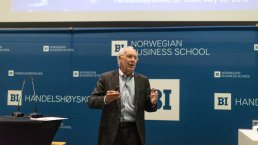Per Espen Stoknes and Jørgen Randers unfold the five measures that will lead to achieving the 17 UN Global Goals within planetary boundaries.
The Club of Rome celebrated its 50th anniversary with a huge gathering at the Italian capital on Wednesday 17th of October 2018. The club’s first report, The limits to growth, published in 1972, resulted in a tremendous uproar and more than 9 million sold books.
So, where do we stand today, almost half a century on?
We led an international research group with participants from the Stockholm Resilience Center, the Norwegian School of Management (BI) and Potsdam which spent the last year working out a completely new version of the data model, based on the United Nations Sustainable Development Goals and knowledge about the critical load that our planet can take. The data model uses more than 100 000 historical data points since the 1970s to simulate what lies ahead of us.
Many people have interpreted the original 1972 report as an attack on economic growth. This was a mistake. The previous report simply argued that if economic growth continues, the world will need to implement policies and investments fast enough to stabilise our physical resource use. Otherwise Earth’s finite life supporting ecosystems will get pushed too far.
The Good News
The good news is that the world has taken some huge steps forward since 1970 in reducing poverty and increase longevity and wealth. The bad news is that this has created massive and growing disparities along with the destruction and destabilisation of forests, oceans, air, soil and water systems.
The new report offers an overview of each sustainable development goal (SDG) for seven of the world’s regions from 2030 to 2050. These goals cover everything from eradicating poverty, improving health and education, economic inequality to ocean acidification, biodiversity and – not least – energy and greenhouse gas emissions.
Our goal has been to understand the extent to which we are on track to reach the 17 goals in the seven regions without paying for it with the destruction of our planet? Or put shorter: Can the world achieve the 17 SDGs within planetary boundaries?

Five Measures for a Better World
To answer that question we simulated four scenarios: The scenario called “Same” calculates business as usual: that we will continue with the rate of change we have seen these last 35 years until 2050. We also examined what a faster economic growth rate would lead to, including renewable energy, more digitisation, innovation and more investments. Or, what if the governments put a lot more political efforts into backing each one of goals than before, working harder on all fronts? The fourth scenario analysed what a socio-economic transformation would look like.
Our calculations for business-as-usual neither significantly improved goal achievement for 2030 from current prognoses, or less destruction of the planet. The current pace of change is too slow – for people and for nature.
Faster economic growth can eliminate poverty and provide better education and health faster than before. The same is true for greater political efforts, but neither of these manage to raise overall sustainability any further from 2030 to 2050. All these options threaten the long-term stability of civilisation. Paradoxically, the sustainability goals then seem to undermine their own sustainability.
The 2020 deadline
But we did identify one, fourth scenario that can deliver on most of the sustainability goals and benefit the planet. This scenario is called “Smarter” and contains five extraordinary new measures. These measures are systemic, in that they are not trying to meet each goal separately, but seem to affect many goals at the same time:
- Accelerated growth in renewable energy and electrification. If investments nearly double from current levels, emissions from coal, oil and gas could be reduced by 50 % each decade going forward. This is economically feasible while also being increasingly profitable.
- New development models for faster growth in developing countries, where relevant models are followed such as in South Korea, China, Ethiopia or Costa Rica.
- Active reduction of economic inequalities with a redistribution of wealth that ensures the richest ten percent do not take more than 40 percent of national income.
- Increasing investments in education for everyone, particularly women in developing countries, along with health care, equal job opportunities and family planning. This will stabilise the population as well.
- Accelerated productivity in the food chain. Feeding nine billion people in 2050 will require less waste and food loss along the entire value cycle from soil-to-table-to-soil by improving resource productivity by one additional percent annually from now until 2050. Solutions for this are available today; they only need investments and a little more progress.
We believe that this fourth scenario is entirely possible and realistic. Market forces already show signs of being able to create a brutal renewable revolution. Sustainable agriculture is developing rapidly. Education is improving and fertility is dropping in all countries. But handling social inequality is probably the most politically challenging aspect here.
Since the launching of the UN sustainability goals in 2015, however, international cooperation seems to be weakened just when it seems to be most needed.
Most analysts and investors agree that keeping the Earth in safe zone to support good lives for all and stable economic development beyond 2050 would be a good investment. But the support for international cooperation can change quickly. That is precisely why we need the Club of Rome’s voice more than ever.
Accelerating this ambitious transformation, to achieve the world’s sustainability goals within planetary boundaries, is probably the very smartest thing people could do right now.
Article published as an opinion piece in the newspaper Dagens Næringsliv on 17 October 2018 by Associate Professor Per Espen Stoknes and Professor Emeritus Jørgen Randers, Department of Law and Governance at the BI Norwegian School of Management. Both are affiliated with BI’s Center for Green Growth.
Story from


